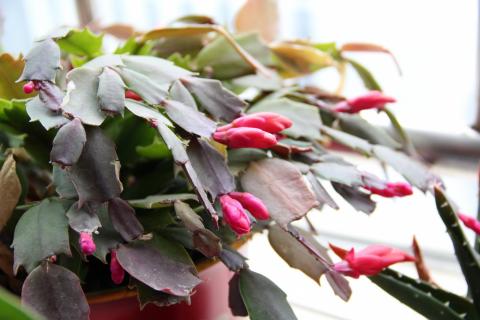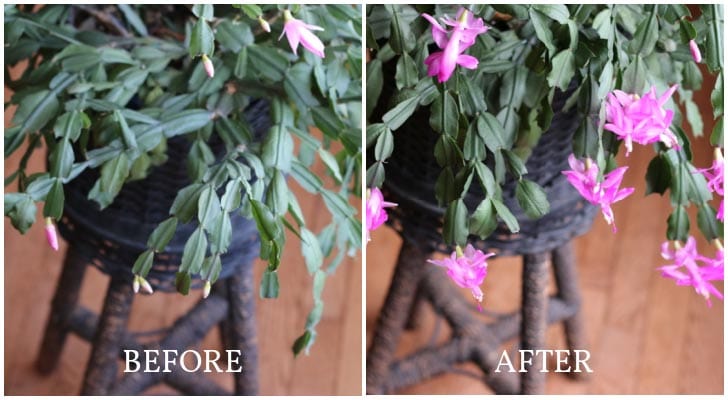
Christmas cacti prefer rainforests to deserts as their natural habitat, and they need watering to keep the soil evenly moist. To mimic the ideal watering cycle and humidity of the Christmas cactus native environment, water it well once per week and spritz the leaves twice per week.
In contrast to most cacti, Christmas cacti are particularly rare in that they are evolved to rainforests rather than deserts. As a result, they require more frequent watering, less sunlight, and higher levels of humidity.
Continue reading to learn when and how much to water your Christmas cactus in order to maintain the ideal moisture balance for its growth.
Table of Contents
How Often to Water Christmas Cactus
The Christmas Cactus (Schlumbergera) is a kind of cactus that thrives in Brazil’s chilly, mountainous woodlands where the humidity is high and rainfall is not infrequent.
In sharp contrast, most cacti want dry, arid, sunny environments in order to grow.
Because Christmas cacti are more suited to cool, damp settings than their desert-dwelling brethren, underwatering is one of the most common issues with growing them.
You must mimic some of the humidity and watering requirements of the Christmas cactus’ natural habitat in order to effectively grow it indoors.
Compared to other indoor plants, Christmas cactus needs a higher humidity level. Twice a week or more, spritz some water on the leaves. Throughout the entire year, give the cactus a weekly soak in water.
In order to prevent issues with bothersome overwatering and underwatering, this frequency of watering in conjunction with the appropriate well-draining potting soil helps to replicate the balance of moisture to which it is accustomed.
For the most of the week, the soil should feel evenly moist, with a tiny surface evaporation before the subsequent watering.
A Christmas cactus may withstand two weeks without watering if it is not in an air current or if the air is not too dry. It is also a little more drought tolerant than other houseplants.
It should be noted that a number of variables can affect how quickly or slowly your Christmas cactus dries out indoors, including:
- Your home’s humidity and temperature (houses are often low in humidity which is contrary to Christmas cactus preference for high humidity).
- The pot or container’s size (smaller pots dry out quickly).
- Whether the cactus is close to a heat source, in an air conditioning current, or in forced air (which saps moisture from the leaves and dries the soil).
- The soil’s ability to hold onto moisture (Christmas cactus require moist yet well draining soil).
It is crucial to wet your Christmas cactus to create a microclimate of enhanced humidity to combat the effects of dry air if you live in an area with low humidity or if the air conditioning is frequently running.
Homes tend to be on the dry side, so I advise misting at least once a week regardless of climate, but in arid areas, mist the cacti twice or three times a week.
Keep in mind that Christmas cacti prefer diffused light over direct sunlight. The cactus would lose too much moisture if the sun was too strong and the leaves were burned.
How to Tell if the Christmas Cactus is Over watered or Under watered…
The only way to tell the difference between overwatering and underwatering is to feel the soil because the cactus might wilt and droop in reaction to either situation.
If you can feel the soil at the base of the pot via the drainage hole and it is dry both above and below, the cactus is being underwatered.
If your soil is rapidly drying out, increase the frequency of your watering over the period of 7 days so that the soil is continuously moist rather than dry.
To raise the humidity and lessen water loss via the leaves, mist the under-watered cactus more frequently.
Check to see if there is anything obstructing the drainage hole and remove any water that may be on a tray or saucer used underneath the pot if the soil feels wet or even saturated.
Scaling back watering and making sure the soil drains well may prevent the cactus from developing and flowering properly and may even result in root rot.
(Read my article Why is my Christmas cactus fading for additional details.)
How Much to Water a Christmas Cactus

While factors like temperature, air currents, and climate change can all affect how much water you need, the amount you use to hydrate Christmas cacti should remain constant.
Give the Christmas cactus a generous bath, letting any extra water drip out the bottom of the pot.
When you water your Christmas cactus, making sure the water soaks in well and reaches the roots will help it to absorb the necessary moisture.
A thorough soak also helps the roots expand and take hold in the potting soil.
Drought can be caused by overwatering, which only moistens the top inch or so of the soil and can lead the roots to grow shallowly or prevent them from ever reaching the water.
It is possible to mimic the natural watering cycle and humidity level that the Christmas cactus is used to by giving it a nice soak and frequent mistings.
(To learn more about why your Christmas cactus may be losing buds, read my article.)
Well Draining Soil Maintains Optimal Balance of Moisture
To maintain Christmas cactus health, it is important to use the proper type of well-draining yet moisture-retentive potting mix. This will allow the soil to remain moist but not wet in order to prevent root rot.
To make sure the soil can hold moisture while allowing extra water to drain away from the roots, combine three parts potting soil with one part horticultural sand or grit.
Christmas cacti, like many other cacti, are epiphytes, which means they get most of their moisture and nutrients from the atmosphere. This is why they like dampness and porous soil.
You may provide a plant the necessary amount of moisture while preventing root rot by utilizing well-draining soil that also retains moisture.
Plant Christmas Cactus in Pots with Drainage Holes

Your pot or container must have drainage holes in the base to allow extra water to drain from the pot’s bottom.
A smart approach to be sure you have applied enough water to permeate the soil and reach the roots of your Christmas cactus is to water until water drips from the pot’s base.
Without drainage holes in the base, water pools around the roots of your cactus, leading to root rot and the plant’s eventual death.
Also to be noted is the preference of Christmas cacti for smaller pots and a slightly root-bound condition, which encourages flowering.
(There are a number of reasons why a Christmas cactus won’t bloom; if this is the case, read my article for the solutions.)
If: Water still collects around the roots and results in root rot.
- Roots or compacted soil cause the drainage holes to clog. If you observe that the soil is draining slowly, make sure that the foundation is open to water flow.
- Under the pots or containers are trays and saucers. Christmas cactus needs soil that drains properly. In the home, trays and saucers are frequently used to stop water from spilling. Regularly empty the tray or saucer to make sure water is not collecting around the roots.
- outside pots that add style. Christmas cacti are frequently offered for sale in stores in aesthetically pleasing outer pots without drainage holes. To avoid root rot, make sure to dump the pot frequently, or just put Christmas cacti in a pot with drainage holes in the bottom.
Key Takeaways:
- To get the ideal balance of moisture, water Christmas cactus once a week with a deep soak and spritz the leaves twice a week. Christmas cacti are indigenous to rainforests and need more moisture and humidity than most other cactus species.
- To make sure water reaches the Christmas cactus roots, always water with a generous soak.
- To help the plant absorb the moisture it needs and prevent root rot, plant Christmas cacti in well-draining soil that keeps some moisture but lets excess water drain away.
- Planting a Christmas cactus requires a pot with drainage holes in the bottom. Regularly empty saucers and trays to avoid the soil remaining wet and encouraging root rot.
FAQ
Why are the leaves on my Christmas cactus limp?
Lack of water or much sunlight can occasionally result in wilted or weak Christmas cacti. Start by giving the wilting Christmas cactus a small amount of water if you haven’t been watering it. Every few days, continue to water carefully until the soil is barely damp.
How often should a Christmas cactus be watered?
every 2 to 3 weeks.
How do I know if my Christmas cactus is dying?
The roots of a cactus that has rot will have blackened tips. Rotten Christmas cactus roots will be sticky with black or brown decomposition, depending on the extent of the illness. It’s imperative to take quick action if you find that your Christmas cactus is rotting.
Do you water a Christmas cactus from the top or bottom?
To ensure that the water reaches the Christmas cactus’ roots, irrigate it from the bottom up. Continue adding water to the soil until it begins to seep through the pot’s openings. It hydrates the ground. Ensure that there is no standing water beneath the pot once the soil has been thoroughly moistened.
How can you tell if a Christmas cactus is overwatered?
When the plant is overwatered, the leaves of the Christmas cactus become yellow. A lack of proper drainage in the soil can also result in the Christmas cactus’ leaves becoming yellow. Christmas cactus root rot is brought on by overwatering. Although it enjoys water more than the other cactus species, avoid letting the plant become saturated.
